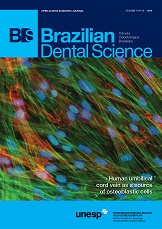Human umbilical cord vein as a source of osteoblastic cells
DOI:
https://doi.org/10.14295/bds.2014.v17i3.986Resumo
Objective: Regenerative medicine and tissue engineering are searching for novel stem cell based therapeutic strategies that will allow for efficient treatment or even potential replacement of damaged organs. The purpose of this work was to study the behaviour of human umbilical cord vein cells (UCVs) through osteoblastic differentiation. Material and Methods: Cells were isolated, expanded and cultivated in osteogenic medium. After 7, 14 and 21 days of culture, there were evaluated cell morphology, proliferation, viability and alkaline phosphatase (ALP) activity. Immunolocalization of ALP was performed after 1, 7 and 14 days of culture and cells were analysed in a fluorescence microscope. Statistical test utilized was Mann-Whitney (p<0.05). Results: The results showed that osteogenic medium induced morphological changes in the UCVs. Besides, it permited cell viability and proliferation, as well as an increase in the alkaline phosphatase expression and activity. Conclusion: It is concluded that these cells can differentiate into osteoblastic-like cells, contributing to applications for cell therapy and tissue engineering.
Downloads
Downloads
Publicado
Como Citar
Edição
Seção
Licença
TRANSFERÊNCIA DE DIREITOS AUTORAIS E DECLARAÇÃO DE RESPONSABILIDADE
Toda a propriedade de direitos autorais do artigo "____________________________________________________________________" é transferido do autor(es) para a CIÊNCIA ODONTOLÓGICA BRASILEIRA, no caso do trabalho ser publicado. O artigo não foi publicado em outro lugar e não foi submetido simultaneamente para publicação em outra revista.
Vimos por meio deste, atestar que trabalho é original e não apresenta dados manipulados, fraude ou plágio. Fizemos contribuição científica significativa para o estudo e estamos cientes dos dados apresentados e de acordo com a versão final do artigo. Assumimos total responsabilidade pelos aspectos éticos do estudo.
Este texto deve ser impresso e assinado por todos os autores. A versão digitalizada deverá ser apresentada como arquivo suplementar durante o processo de submissão.




























